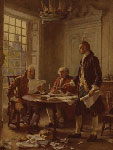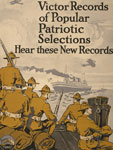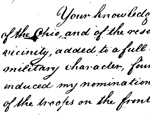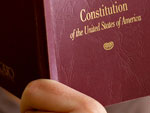Teaching the Declaration without Overwhelming Students

How might I teach the Declaration of Independence to high school students who are visual and verbal learners? What films or reading assignments will engage them, and yet not overwhelm them with the sometimes difficult wording of the Declaration itself?
Ah, the Declaration of Independence, a document so essential to understanding our American past and present that every student should read and learn about it. Luckily, its ideas and historical significance are truly engaging and can help make its difficult eighteenth century prose more accessible for our students.
Below are some ideas:
How about starting with an idea or line from the document? One of our favorites is the line regarding the right and duty for those threatened with absolute tyranny to “throw off such government.” This is one of several powerful ideas in the Declaration that can engage students before they confront the entire document. (It could also be just considering the document’s title! Declaring independence is something most adolescents can get their heads around and this can lead into exploring when and why this might happen and how one might frame such a declaration to win supporters. Consider what “The unanimous Declaration of the thirteen united States of America,” signaled to readers on both sides of the Atlantic and how they had gotten to this radical place.)
Considering the historical and contemporary significance of the document can also engage. Do students have a grasp of the road to Revolution, do they understand the chain of events and rising discontent in the Colonies? The risk to the signers? The historical moment? This background knowledge can help students in understanding the import of the document and its prose. Or look at instances where the document serves as a model (the Seneca Falls Declaration)
or reference point (MLK’s reference to it as “promissory note” in his I Have a Dream Speech)
As far as reading the document, we suggest two intertwined approaches (both to be used with a transcribed version).
1. Help students see the structure of the document so they know what to expect. Show them how it moves from initial paragraphs that get what the states are doing and why, to a list of specific grievances, to assurances that these are not capricious complaints or actions and then the ultimate declaration.
2. Plan activities where they read excerpts from the document closely and carefully. Phrases and sentences work here—select them carefully and scaffold student work with strategies like pair work, paraphrasing, and vocabulary help.
Some other ideas include:
Looking at the original document.
Sign the document. Have students find the anomaly (your signature) on a handout or decide whether to sign on themselves after considering the stories behind the signers and the historical moment.
Look at the rough draft of the Declaration or use this lesson plan which involves a careful comparison between the drafts.
For a primer on the document, see this historian’s helpful discussion that includes a consideration of the historical events surrounding the Declaration, analyses of particular excerpts and its consequences and legacy.
See the Library of Congress’ Web Guide
Connect with images. For example, this one or this one.
Admittedly, we focus on the reading of the document. There are several resources like the recent film National Treasure, the older film 1776, or the Independence episode of the recent TV miniseries John Adams that some teachers use to talk about the Declaration of Independence.
A new way to bring visual learners to the text of the Declaration is through YouTube. Your students may be interested in this video clip of well-known actors reading the Declaration in its entirety .
While these resources could be used to accompany the kinds of reading activities we mention here, it would be too bad if they trumped the actual Declaration, a document that talked about equality before our Constitution did and deserves every student’s eye.

 The template for the computer interactive is a real rough draft of the Declaration of Independence, complete with edits made by Thomas Jefferson, John Adams, and Benjamin Franklin. On the "Overview" page, students can scroll their mouse over Thomas Jefferson's original script, transforming sections from the original handwriting to student-friendly printed font with word-processor-style edits.
The template for the computer interactive is a real rough draft of the Declaration of Independence, complete with edits made by Thomas Jefferson, John Adams, and Benjamin Franklin. On the "Overview" page, students can scroll their mouse over Thomas Jefferson's original script, transforming sections from the original handwriting to student-friendly printed font with word-processor-style edits. 




